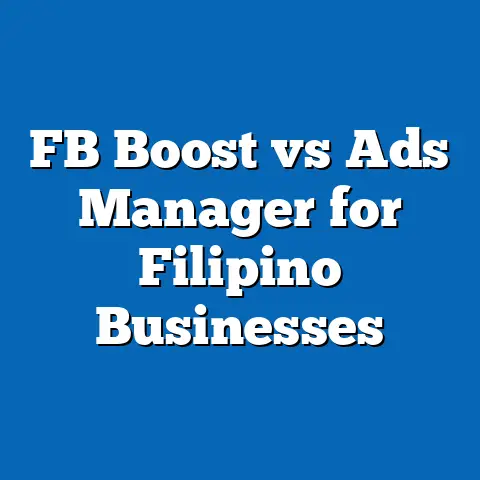Boost Filipino Ecommerce Sales: Secrets from USA Facebook Ads!
Boost Filipino Ecommerce Sales: Secrets from USA Facebook Ads!
Introduction: The Power of Adaptability in Facebook Ads
In the fast-changing world of ecommerce advertising, adaptability is not just an advantage — it’s a must. Over the years, I’ve seen countless Filipino ecommerce businesses struggle to figure out Facebook ads. Some pour money into campaigns without a clear plan, while others hesitate to spend at all, fearing wasted budgets. I’ve been in their shoes. When I first started managing Facebook ads for Filipino brands, I quickly realized that success came down to how well you adapt your strategies to shifting algorithms, consumer behavior, and market trends.
Take my early experience with a small Manila apparel shop. They were spending ₱20,000 monthly on Facebook ads but barely breaking even. By applying tested USA marketing tactics — like segmenting audiences and pacing budgets according to sales cycles — and adjusting them for our local context, we doubled their sales in three months without increasing their ad spend. This taught me that understanding data deeply and being flexible with your budget can transform your results.
In this article, I’ll share proven secrets from USA Facebook ad campaigns adapted for the Filipino market. You’ll get detailed budgeting formulas, data-backed insights, real case studies, and practical tips that you can implement today to boost your ecommerce sales.
Common Pain Points Filipino Ecommerce Businesses Face with Facebook Ads
Before we dive deep, let’s acknowledge the pain points many SMBs have shared with me:
- “I don’t know how much budget is enough or too much.”
Many businesses just guess or copy what competitors spend without understanding their own numbers. - “I spend money on ads but sales don’t come.”
This happens when targeting or creatives don’t connect or when budgets are wasted on low-intent audiences. - “Facebook ads feel like throwing darts blindfolded.”
Without clear tracking and optimization, ad spending feels random and risky. - “How can I be sure I’m not wasting money?”
This is where data-driven budgeting and strategy come in.
If any of these sound familiar, you’re in the right place.
Why Look to USA Facebook Ads Strategies?
You might ask: The Philippines is very different from the USA — can we really apply their strategies?
Yes — but with adaptation.
The USA ecommerce market is one of the most mature and competitive globally. Advertisers there have access to huge datasets and have tested countless strategies. They’ve optimized budgets down to the peso, learned which audiences convert best, and how to time their campaigns around buying cycles.
Filipino consumers are increasingly online and mobile-first — our social media usage is among the highest worldwide. According to We Are Social’s Digital 2024 report:
- Filipinos spend 4+ hours daily on social media.
- Facebook remains the top platform.
- Mobile accounts for over 90% of social media access.
This makes Facebook a goldmine for ecommerce if you apply the right budget strategy.
Deep Dive into Key Facebook Ad Metrics Every Filipino Ecommerce Business Must Know
1. Cost Per Click (CPC)
CPC is how much you pay each time someone clicks your ad. In the USA ecommerce sector, CPC averages around $0.97 or roughly ₱54 (exchange rate dependent). For Filipino markets, CPC tends to be lower due to less competition — typically between ₱5 – ₱12 per click ($0.10 – $0.22).
Lower CPC means more clicks for less money but doesn’t guarantee sales.
2. Click Through Rate (CTR)
CTR measures how many people who see your ad actually click it.
USA average CTR for ecommerce ads is about 1.91%. In the Philippines, it varies based on niche but generally ranges between 1.5% – 2.5%.
Higher CTR usually means your ad creatives are relevant and compelling.
3. Conversion Rate (CVR)
CVR tells you how many clicks turn into actual sales or leads.
USA ecommerce sites average a 2.35% conversion rate, while Philippine sites vary around 1.5% – 3%, influenced by product type, website experience, and payment methods.
4. Return on Ad Spend (ROAS)
ROAS measures revenue earned for every peso spent on ads.
A ROAS of 4:1 in the USA means earning ₱4 for every ₱1 spent. In the Philippines, typical ROAS averages between 2:1 and 3:1 due to market differences.
How to Calculate Your Ideal Facebook Ad Budget Step-by-Step
Budgeting is both an art and science. To take control of your ad spend instead of guessing blindly, use this formula-based approach:
Step 1: Define Your Sales Goal
Decide how much revenue you want monthly or quarterly.
Example: ₱100,000 monthly sales target.
Step 2: Know Your Average Order Value (AOV)
Calculate average amount spent per order on your site.
Example: ₱1,000 per order.
Step 3: Calculate Number of Orders Needed
Orders Needed=Sales GoalAOV=100,0001,000=100\text{Orders Needed} = \frac{\text{Sales Goal}}{\text{AOV}} = \frac{100,000}{1,000} = 100
Step 4: Know Your Conversion Rate (CVR)
If your website converts at 2%:
Step 5: Calculate Clicks Needed
Clicks Needed=Orders NeededCVR=1000.02=5,000\text{Clicks Needed} = \frac{\text{Orders Needed}}{\text{CVR}} = \frac{100}{0.02} = 5,000
Step 6: Determine Average Cost Per Click (CPC)
Suppose CPC is ₱8.
Step 7: Calculate Ad Budget
Budget=Clicks Needed×CPC=5,000×8=₱40,000\text{Budget} = \text{Clicks Needed} \times \text{CPC} = 5,000 \times 8 = ₱40,000
So to hit ₱100k sales goal with these metrics, allocate ₱40k monthly ad budget.
Why This Approach Works Better Than Flat Budgets
Many SMBs simply allocate a fixed percentage of revenue or just “whatever they can afford.” Without linking budget to goals or conversion data, this often leads to either overspending or underfunding campaigns.
By basing budget on expected sales volume and conversion rates, you make sure your spend aligns with business goals and actual performance metrics — maximizing ROI while controlling risk.
Breaking Down Complex Concepts: Understanding Funnel Stages & Budget Allocation
Facebook ads work best when structured around the buyer’s journey or funnel stages:
| Funnel Stage | Objective | Budget Focus |
|---|---|---|
| Awareness | Reach & Impressions | ~20% |
| Consideration | Traffic & Engagement | ~30% |
| Conversion | Sales & Leads | ~50% |
In the Philippines, where trust plays a big role in online purchases, putting more budget towards retargeting warm audiences (consideration/conversion stages) tends to increase ROAS faster than broad cold traffic campaigns alone.
Unique Insights from USA Case Studies & Their Application to Filipino Ecommerce
Case Study #1: Lookalike Audiences Boost Profitability by 30%
A US-based skincare brand used Facebook Lookalike Audiences (LA) at 1% and 5% levels based on customer purchase data. By focusing ad spend on these highly similar users rather than broad targeting:
- They saw a 30% rise in ROAS.
- Reduced wasted spend on uninterested users.
- Successfully scaled budget by 50% without ROAS dropping.
Applying this in PH:
Start small by creating Lookalikes from your best customers or website visitors using Facebook Pixel data. Scale gradually once you see consistent engagement and conversions.
Case Study #2: Using Budget Pacing Based on Demand Cycles
A US ecommerce company tracked daily sales patterns and adjusted daily Facebook budgets accordingly:
- High-budget days aligned with payday weekends.
- Lower spend during slow weekdays.
- This reduced wasted budget during low-conversion periods by up to 25%.
Applying this in PH:
Understand local shopping habits — weekends, holidays like Araw ng Kagitingan or Christmas season — and increase daily budgets during those spikes while conserving funds during slow days.
Practical Tips for Optimizing Your Facebook Ad Spend in the Philippine Context
Tip #1: Start Small & Test Quickly
Avoid committing big budgets upfront. Start with ₱500 – ₱1,000 daily budgets while testing different creatives and audiences for at least two weeks before scaling.
Tip #2: Use Campaign Budget Optimization (CBO) Judiciously
Facebook’s CBO automatically distributes your total campaign budget across ad sets based on performance. However:
- Monitor frequency closely.
- Pause poorly performing ad sets.
- Don’t over-rely; manual adjustments can sometimes yield better control.
Tip #3: Invest in Mobile-First Creatives
Since over 90% of Filipinos access Facebook via mobile:
- Use vertical videos (9:16).
- Quick-loading images.
- Clear text overlays.
- Use Filipino language or Taglish for relatability.
Tip #4: Leverage Local Holidays & Events
Plan ahead for spikes during Christmas season (Nov-Dec), “Ber” months promos, Valentine’s Day, and local festivals like Sinulog or Ati-Atihan by increasing budgets strategically.
Tip #5: Monitor Frequency & Avoid Ad Fatigue
Keep ad frequency below 3 per week per user to prevent burnout. Rotate creatives every 7-10 days to keep content fresh.
How to Track & Analyze Your Facebook Ads Effectively
If you’re not tracking properly, budgeting becomes guesswork:
- Use Facebook Pixel installed on your ecommerce site to track conversions.
- Set up custom conversions based on checkout completions or add-to-cart events.
- Regularly review Ads Manager reports focusing on CPC, CTR, CVR, CPM (cost per mille), frequency.
- Use breakdown reports by age, gender, placement to understand your best-performing segments.
- Adjust budgets weekly based on these insights — increase spend only on well-performing sets.
Deep Dive into Audience Targeting Strategies That Work
Custom Audiences
Use data from email lists, website visitors (via Pixel), and app users to retarget warm audiences who already know your brand.
Lookalike Audiences
Create audiences similar to your best customers at different similarity percentages (1%, 3%, 5%). Start with tighter LAs then expand as you scale budgets.
Interest & Behavior Targeting
Target interests related to your product category but combine with demographic filters like age or location for precise reach.
Real-World Example #2: Budgeting for a Filipino Online Food Delivery Brand
Let’s say you run a meal kit delivery service in Metro Manila:
- Average order value (AOV): ₱700
- Conversion rate (CVR): ~2%
- Cost per click (CPC): ₱6
- Goal: ₱70k monthly sales
Steps:
- Orders Needed = 70,000/700=10070,000 / 700 = 100
- Clicks Needed = 100/0.02=5,000100 / 0.02 = 5,000
- Budget = 5,000×6=₱30,0005,000 \times 6 = ₱30,000
You’d allocate ₱30k monthly on Facebook ads targeted around lunch hours with creatives showing fresh meals and convenience emphasized.
How to Write High-Converting Facebook Ad Copy for Filipino Consumers
Filipinos respond well to emotional storytelling and social proof:
- Use relatable Tagalog/Taglish phrases like “Sarap na swak sa budget!” or “Para sa pamilya mo yan!”
- Highlight promotions clearly (“Buy one take one!” or “Libre shipping sa orders above ₱1000!”)
- Include testimonials or user-generated content.
- Use emojis sparingly but effectively to catch attention.
Example headline:
“Masarap at abot-kayang pagkain? Order na sa [Brand]!”
Expert Quotes from Filipino Facebook Advertisers
“Filipino buyers appreciate authenticity — ads that speak like friends get higher engagement.”
— Ana Villanueva, Social Media Strategist
“Data is king but creativity wins hearts — combining both is crucial.”
— Mark Dela Cruz, Ecommerce Consultant
Advanced Budgeting Techniques: Scaling Without Losing ROAS
Once you find winning campaigns:
- Increase daily budgets by no more than 20% every 3 days.
- Duplicate ad sets instead of increasing budgets too fast.
- Test new creatives alongside existing winners.
- Monitor frequency closely to avoid burnout.
This approach keeps ROAS steady as you grow spend.
Common Mistakes Filipino Ecommerce Businesses Make With Facebook Ads Budgets
- Spending heavily on broad cold audiences without retargeting.
- Ignoring mobile optimization leading to high bounce rates.
- Not tracking conversions properly; relying only on clicks or impressions.
- Letting ad frequency get too high causing negative brand perception.
- Not adjusting budgets based on sales cycles or performance data.
Avoid these pitfalls by following the data-driven steps outlined above.
Visual Guide: Budget Allocation Example Breakdown
(Imagine here a pie chart showing distribution)
- Awareness Campaigns: ₱8,000 (20%)
- Consideration Campaigns: ₱12,000 (30%)
- Conversion Campaigns: ₱20,000 (50%)
How Local Culture Influences Facebook Ad Strategy
Filipinos value kapwa (shared identity), bayanihan (community spirit), and often buy based on recommendations from family/friends. Ads that incorporate these values — showing family scenarios or community support — tend to perform better.
Tools & Resources for Managing Your Facebook Ads Budget Efficiently
- Facebook Ads Manager: For campaign management & reports.
- Google Analytics: Cross-check ecommerce conversion data.
- Canva: For creating mobile-friendly creatives easily.
- Facebook Pixel Helper: To verify Pixel installation.
- Excel/Google Sheets: To track budget vs sales manually if needed.
Summary & Actionable Next Steps for Filipino Ecommerce Businesses
- Set clear monthly sales goals based on realistic AOV and CVR.
- Calculate your ideal ad budget using the formulas above.
- Start with small daily budgets and test creatives/audiences thoroughly.
- Use Facebook Pixel for accurate conversion tracking.
- Leverage custom and lookalike audiences for better targeting.
- Adjust budgets dynamically according to local demand cycles.
- Optimize creatives for mobile-first experience in Tagalog/Taglish.
- Monitor frequency and rotate ads regularly.
- Scale budgets gradually with close monitoring of ROAS.
- Learn continuously from local case studies and global best practices.
By combining these proven USA insights tailored specifically for Filipino ecommerce businesses with disciplined budgeting and continuous optimization, you can unlock greater sales growth without risking wasted ad spend.
Remember that success on Facebook ads is not about spending more blindly; it’s about spending smarter — adapting fast based on real data and local insights to win Filipino customers’ hearts and wallets.
Salamat sa paglalaan ng oras mo para basahin ito! Handa ka na bang simulan ang iyong e-commerce growth journey gamit ang tamang Facebook Ads budget strategy? Tara na!






